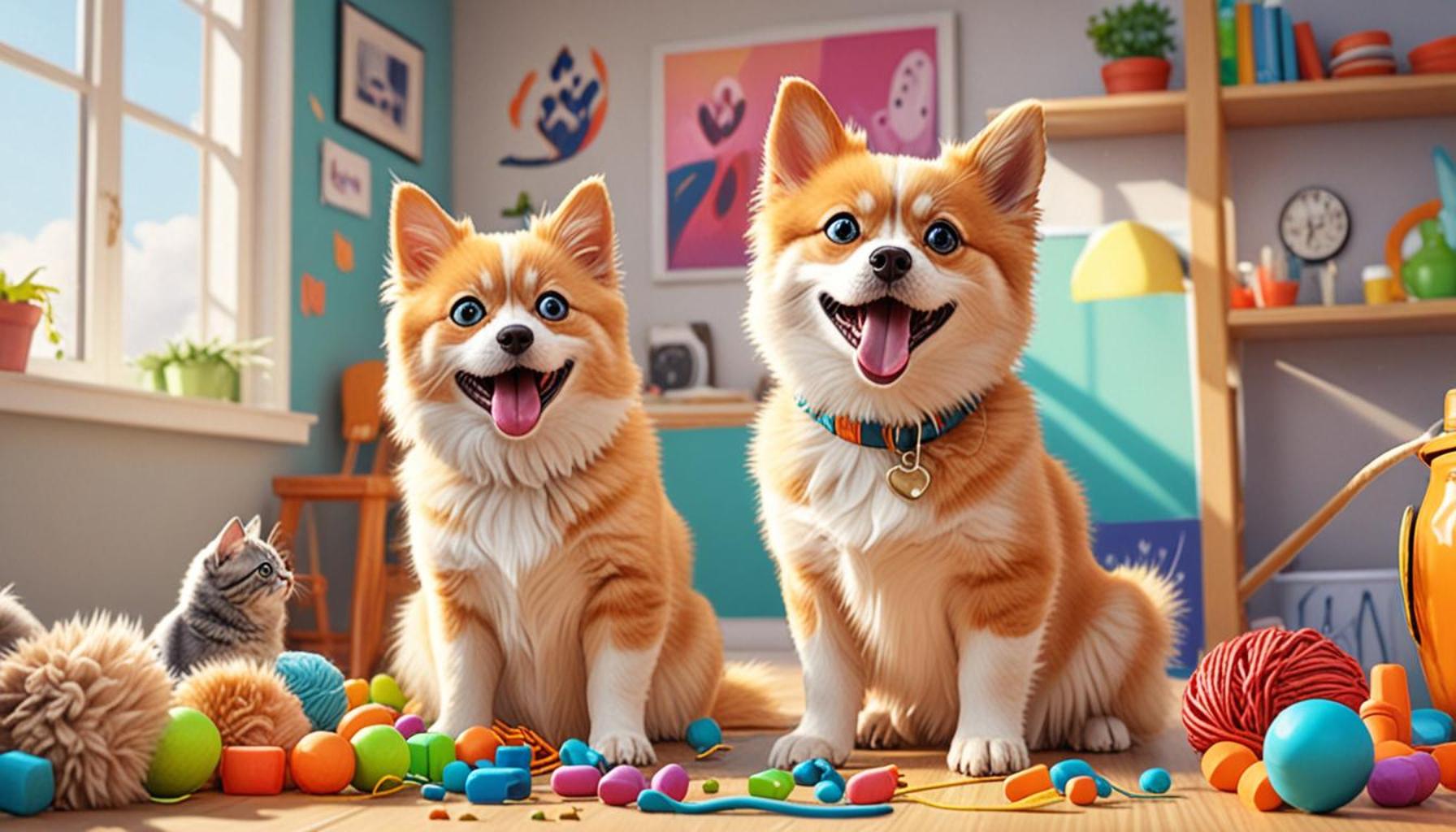The Importance of Consistency in Pet Training

Understanding the Role of Consistency in Pet Training
Training your pet can often feel like a journey filled with challenges and rewards. However, the key to achieving desirable behavior lies in one essential element: consistency. A consistent approach in pet training ensures that your furry friend understands expectations and learns in a positive environment.
Consider these critical aspects of why consistency matters:
- Establishing Clear Communication: Using the same commands for specific actions helps pets link words with actions. For example, if you want your dog to sit, consistently using the command “sit” instead of alternating with phrases like “sit down” or “plop” leads to faster comprehension. The clearer and more precise your language, the easier it is for your pet to follow.
- Building Trust: When training is predictable, your pet feels secure, which fosters a stronger bond. Consistency not only involves the words you use but also the tone of voice and body language. For instance, giving praise every time your pet successfully follows a command helps solidify that behavior, making them more likely to perform it again in the future. Without consistent reinforcement, behaviors can become confusing or even lead to anxiety.
- Accelerating Learning: Regular routines lead to quicker understanding and retention of behaviors. For example, if you reinforce good behavior immediately with treats and affection, your pet will associate that positive outcome with the action they performed. This positive feedback loop is crucial in solidifying the learning process.
In the United States, many pet owners struggle with inconsistency, which can lead to confusion for pets. Statistics show that approximately 50% of dog owners report difficulties in training their pets due to mixed signals from family members or varying approaches to discipline. It’s crucial to have both pet trainers and owners alike embrace techniques that reinforce uniformity. Consistency not only enhances learning but also elevates the pet-owner relationship by establishing a sense of reliability and security for your four-legged companion.
As you explore the world of pet training, remember that small, consistent steps can yield remarkable results. Take the time to plan out your training strategy, ensuring everyone in the household is on the same page. For example, appoint one person as the primary trainer for the initial stages, while gradually introducing other family members to the established commands and techniques. This foundational approach will set the stage for a well-behaved and happy companion.
In conclusion, embracing consistency in training fosters a deep connection between you and your pet, creating a harmonious living environment. By using clear communication, building trust, and promoting accelerated learning, you not only enhance your pet’s behavior but also enrich your shared experiences. In the end, the effort you put into maintaining consistency will pay off in the form of a faithful, obedient companion.
DISCOVER MORE: Click here to delve into the impact of gut health on your pet’s lifespan
How Consistency Shapes Effective Training Techniques
In the ever-evolving landscape of pet training, the concept of consistency emerges as a pivotal factor in achieving successful results. Consistency in training doesn’t merely refer to sticking to routines; it encompasses a broad spectrum of elements that are essential for shaping acceptable behaviors in pets. Understanding how these components play into consistency can illuminate the path towards a well-mannered companion.
A crucial aspect of consistency is establishing routine. Engaging with your pet at the same times daily—whether for training sessions, feeding, or play—helps create a predictable environment. Animals thrive on routines, as they come to expect what will happen next. For instance, dogs might become more receptive to commands when they recognize training takes place every evening after dinner. This kind of reliable schedule not only aids learning but also enhances the bond between owner and pet.
Moreover, consistency also refers to the reinforcement of rules. Pets require clear guidelines to understand which behaviors are desirable and which are not. For example, if a dog is allowed on the couch one day and shooed off the next, it is likely to feel confused and may not understand how to behave. By applying uniform rules, owners ensure their pets recognize the boundaries and adjust their behavior accordingly. This leads to a more harmonious living environment devoid of misunderstandings.
In the context of pet training, communication plays an integral role. Using the same commands across all situations is vital. For example, teaching a dog to “stay” should strictly involve the word “stay,” without variations like “hold it” or “wait there.” This helps the pet develop an association between the command and the desired action quickly. It involves not only words but also body language. Consistent gestures, such as hand signals accompanying verbal commands, further reinforce learning and deepen understanding.
To underline the importance of consistency in pet training, consider the following key points:
- Predictability leads to familiarity—animals are more likely to respond positively in consistent training settings.
- Cohesion among trainers: When multiple people interact with a pet, maintaining the same language and rules minimizes confusion.
- Positive reinforcement is essential; rewarding the right behavior immediately after it occurs solidifies new skills and improves retention.
The necessity for consistency is especially underscored when integrating new training techniques. For instance, if your goal is to teach a dog to stop jumping on guests, it’s crucial that all family members apply the same approach—whether that’s asking guests to ignore the jumping or consistently reprimanding the behavior. The lack of uniformity can cause confusion, thus hindering the training process.
In summary, the importance of consistency in pet training cannot be overstated. It not only enhances the learning process but also establishes a balanced and trusting relationship between you and your pet. By adhering to structured routines, clear communication, and uniform rules, you pave the way for a well-trained, happy companion who knows exactly what is expected of them. As you embark on your training journey, remember that consistency is the thread that weaves a tapestry of successful and meaningful interactions with your pet.
| Category | Advantages |
|---|---|
| Improved Behavior | Consistent training helps pets understand expected behaviors, reducing confusion. |
| Strengthened Bond | Regular training sessions create trust and enhance the relationship between pet and owner. |
| Effective Communication | Clear commands ensure pets respond accurately to cues, establishing better communication. |
| Reduced Anxiety | Routine training can alleviate anxiety in pets, creating a sense of stability in their environment. |
Consistency in pet training is a fundamental principle that not only benefits the pet’s learning process but also enhances the overall dynamics of the human-animal relationship. When training is applied consistently, each command becomes associated with a specific action, leading to quicker comprehension by pets. This organized approach to training is invaluable as it prevents the confusion that might arise when commands or expectations vary. Moreover, engaging in training sessions regularly provides pets with routine and structure, which are essential for their emotional well-being. Pets thrive on predictability, and a consistent training approach creates an atmosphere where they feel secure. This security ultimately translates to improved behavior, minimizing behavioral issues that can arise from misunderstandings or anxiety. In the context of a busy lifestyle, setting aside time for training not only reinforces behavioral skills but also strengthens the bond between the pet and its owner. This relationship enhancement is crucial for ensuring that the pet feels loved and secure, nurturing a deeper connection that stands the test of time. As pet owners explore the myriad of benefits that come with consistent training, they’ll find that the effort invested yields passionate rewards, making every training moment a step toward a harmonious coexistence.
DISCOVER MORE: Click here to learn about the impact of dental health on your pet’s quality of life</p
Building Trust Through Consistency
While the mechanics of training are crucial, the underlying emotional dynamics that unfold during this process cannot be overlooked. Trust is an essential ingredient in any relationship, and this holds true for the bond between pets and their owners. When owners display consistency in their training approach, pets, in turn, feel safer, more secure, and more likely to engage positively with their humans. This connection leads to a deeper level of understanding and respect, ultimately fostering a well-behaved animal.
Moreover, a pet’s success in training is also influenced by their mental state. Inconsistent training can lead to confusion, anxiety, or even behavioral issues such as aggression or submission. Dogs and cats alike thrive on predictability; when they know what to expect during training sessions, they are more likely to remain focused and engaged. For example, if a dog is trained to fetch but is intermittently scolded for running away with the ball, it may become hesitant to participate in the game altogether. Adhering to a consistent style reduces anxiety and lays the groundwork for a productive learning environment.
The role of positive reinforcement is invaluable in the training process. Utilizing consistent rewards for desired behaviors reinforces the learning experience and creates a positive association with training. Studies show that dogs respond more effectively to training methods that incorporate immediate rewards. This can be in the form of treats, praise, or playtime, but the delivery must be uniform and predictable. When a dog performs a command correctly and receives a reward every time, it solidifies its understanding of that behavior. Over time, this practice can lead to automatic behaviors that require minimal prompting.
An effective training regimen also involves adjusting expectations according to the pet’s personality and learning style. Recognizing that no two pets are alike is vital for maintaining consistency. For instance, some dogs may be more eager to please, making them responsive to corrections and commands. In contrast, a shy or timid pet may require a gentler approach. Tailoring your training style while maintaining consistent rules and commands can foster a safe space for learning. This awareness not only respects the individuality of each pet but also shows the owner’s commitment to their development.
Another often-overlooked component of consistency in pet training is the need for patience. Rapid changes in expectations or training methods can hinder progress, as pets need time to acclimate to their learning environment. A consistent training schedule allows both owner and pet the opportunity to work through challenges without the added pressure of constant adjustments. Adopting a patient outlook helps build resilience in both parties, allowing for gradual improvements without overwhelming either side.
Furthermore, leveraging community resources can also ensure consistency in training. Owners should consider enrolling their pets in group classes or working with professional trainers to receive guidance on maintaining a steady training pace. These structured settings offer not only new experiences for pet socialization but also foster an environment where consistent techniques can be learned and applied effectively. Group settings encourage camaraderie among pet owners, which can further lead to shared accountability in supporting one another’s training endeavors.
In essence, the multifaceted nature of consistency in pet training extends far beyond routine commands. By nurturing trust, understanding individual personalities, and employing steadfast methodologies, pet owners can lay the foundation for an effective training experience. The outcome is a well-adjusted pet that exhibits positive behaviors stemming from a trusting and consistent relationship with its owner.
DISCOVER MORE: Click here to learn how physical activity can enhance your pet’s mental health
Conclusion: The Cornerstone of Successful Pet Training
In conclusion, consistency in pet training serves as the cornerstone for building a strong, trusting relationship between pets and their owners. It not only aids in effective learning but also fosters an environment where pets can thrive emotionally and socially. When owners adopt a uniform training approach, pets feel more secure and understood, paving the way for better behavior and greater responsiveness to commands.
Furthermore, by emphasizing principles such as positive reinforcement and tailoring training methods to suit individual personality types, pet owners can create more efficient and compassionate training experiences. Harnessing patience allows both pets and owners to progress at a comfortable pace, mitigating stress and confusion. It also strengthens the bond as both parties navigate the learning journey together.
Moreover, utilizing community resources—such as group classes—can enhance consistency and open opportunities for socialization, helping pets not only to learn commands but also to engage positively with other animals and people. Ultimately, this multifaceted approach culminates in a well-adjusted pet that not only displays good behavior but also exhibits trust and affection towards their human companions.
As you reflect on your pet training endeavors, remember that the path to success is paved with consistency and understanding. Engage with your pet in a loving, structured manner, and watch your bond grow alongside their behaviors. The journey might be challenging at times, but the rewards of a well-trained and happy pet are well worth the effort.


